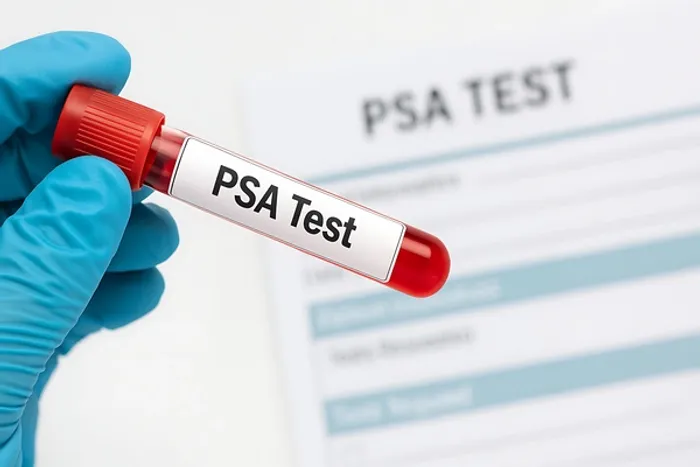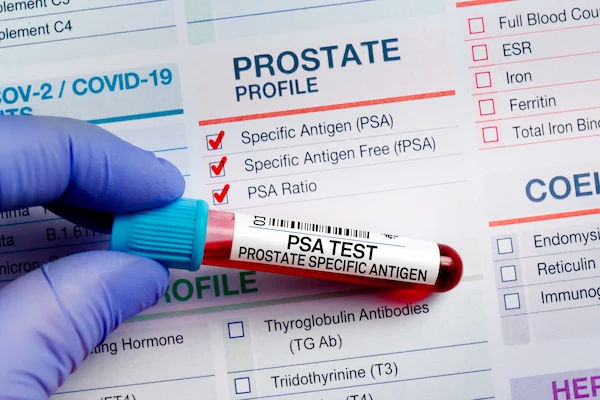Guide to Prostate Cancer Screening And Psa Test
Considering prostate cancer screening? Learn about the PSA test, what your results mean, and who should be screened. Get clear, expert guidance on your prostate health options.

Written by Dr. Dhankecha Mayank Dineshbhai
Reviewed by Dr. Md Yusuf Shareef MBBS
Last updated on 6th Oct, 2025

Introduction
Prostate cancer is one of the most common cancers affecting men, but thanks to advances in screening and treatment, it is also highly treatable when detected early. At the heart of this early detection effort is the PSA test, a simple blood test that has revolutionized prostate health management. However, the decision to get screened isn't always straightforward. This guide will walk you through everything you need to know about prostate cancer screening and the PSA test. We'll demystify what the results mean, explore the current guidelines, and honestly discuss the benefits and risks. Our goal is to empower you with the knowledge to have an informed conversation with your doctor about what's best for your health. Whether you're approaching the age for screening or are simply curious about prostate cancer prevention, this article will provide clarity on this critical aspect of men's health.
What is Prostate Cancer?
Prostate cancer develops in the prostate, a small, walnut-shaped gland in men that produces seminal fluid. It occurs when cells in the prostate gland mutate and begin to multiply uncontrollably. While some types of prostate cancer are aggressive and can spread quickly, many are slow-growing and may not cause significant harm during a man's lifetime. This variability is a key reason why screening decisions are personalized. Understanding the nature of this cancer is the first step in appreciating why screening tools like the PSA test are so important, yet require careful interpretation. Early-stage prostate cancer often has no symptoms, which is why screening becomes crucial for detection before it advances.
The PSA Test: A Cornerstone of Screening
The Prostate-Specific Antigen (PSA) test is the primary tool used to screen for prostate cancer. It's a blood test that measures the level of PSA, a protein produced by both cancerous and noncancerous tissue in the prostate.
Consult Top Specialists
What is PSA (Prostate-Specific Antigen)?
PSA is a protein enzyme that helps keep semen in a liquid state. It's normal for a small amount of PSA to be present in the bloodstream. However, when the prostate is disturbed—whether by cancer, infection (prostatitis), enlargement (benign prostatic hyperplasia, or BPH), or even vigorous exercise—it can release more PSA into the blood, causing the level to rise. The PSA test doesn't diagnose cancer on its own; instead, it acts as an indicator that something may be affecting the prostate, warranting further investigation.
How is the PSA Test Performed?
The PSA test is straightforward. It involves a standard blood draw, typically from a vein in your arm. No special preparation, like fasting, is usually required. However, it's important to inform your doctor if you've recently had a urinary catheter, a prostate biopsy, or a urinary tract infection, as these can significantly skew the results. The blood sample is sent to a laboratory for analysis, and your doctor will discuss the results with you, usually within a few days. For convenience, services like Apollo24|7 offer home collection for tests like the PSA, making the process easier.
Who Should Get Screened for Prostate Cancer?
Screening recommendations are not one-size-fits-all. They are based on age, family history, and overall health, reflecting the need to balance early detection with the risks of over-testing.
General Screening Guidelines by Age
Major health organizations agree that men should discuss the potential benefits and risks of PSA screening with their doctor starting at age 50 if they are at average risk. For men aged 55 to 69, this discussion is most critical, as this is the age group where screening has the strongest evidence for reducing the risk of dying from prostate cancer. For men over 70 or those with a life expectancy of less than 10-15 years, routine screening is generally not recommended, as the potential harms may outweigh the benefits.
High-Risk Groups: When to Start Earlier
Men at a higher risk should begin this conversation earlier. This includes:
- Black Men: They have a higher incidence of prostate cancer and are more likely to develop aggressive forms. Screening discussions often start at age 45.
- Men with a Family History: If you have a father or brother who had prostate cancer, especially if they were diagnosed at a young age, you are at increased risk. Screening is typically recommended starting at age 40-45.
Interpreting Your PSA Test Results
Understanding your PSA number is more nuanced than just "high" or "low." Context is everything.
What is a "Normal" PSA Level?
Traditionally, a PSA level below 4.0 nanograms per milliliter (ng/mL) was considered normal. However, we now know this is an oversimplification. A level below 4.0 ng/mL doesn't completely rule out cancer, and a level above 4.0 ng/mL doesn't automatically mean cancer is present. For example, a younger man with a PSA of 2.5 ng/mL might warrant closer watch than an 80-year-old with the same level. Doctors now look at the PSA test normal range by age, with lower thresholds expected for younger men.
Factors That Can Affect Your PSA Level
Many conditions besides cancer can cause an elevated PSA. It's crucial to consider these to avoid unnecessary worry and procedures:
- Benign Prostatic Hyperplasia (BPH): A non-cancerous enlargement of the prostate common in older men.
- Prostatitis: An inflammation or infection of the prostate gland.
- Urinary Tract Infection (UTI)
- Recent Medical Procedures: Catheter use or a cystoscopy.
- Vigorous Activity: Activities like cycling can sometimes irritate the prostate and temporarily raise PSA.’
Understanding PSA Velocity and Density
Doctors don't just look at a single number. They assess trends over time:
- PSA Velocity: The rate at which your PSA level changes over time. A rapid rise may be more concerning than a stable, slightly elevated level.
- PSA Density: This compares the PSA level to the size of the prostate (measured via ultrasound or MRI). A high PSA in a large prostate (high BPH) may be less suspicious than the same PSA in a small prostate.
The PSA Controversy: Weighing the Benefits and Risks
The widespread use of the PSA test has sparked important debates in the medical community, centered on balancing its life-saving potential against the risk of causing harm through overdiagnosis.
The Benefit: Early Detection Saves Lives
The primary benefit is clear: the PSA test can detect prostate cancer at an early, localized stage when it is most treatable. Studies have shown that PSA screening can reduce the risk of dying from metastatic prostate cancer. For many men, early detection leads to successful treatment and long-term survival.
The Risks: Overdiagnosis and Overtreatment
This is the core of the controversy. PSA screening can detect slow-growing cancers that would never have caused symptoms or death during a man's lifetime. This is called overdiagnosis. The problem is that once a cancer is found, it often leads to treatment (like surgery or radiation) that can have significant side effects, including erectile dysfunction and urinary incontinence. This unnecessary treatment is called overtreatment. This is why "active surveillance"—monitoring low-risk cancer instead of immediately treating it—has become a standard and important management strategy.
What Happens After an Elevated PSA?
If your PSA level is elevated, it does not mean you have cancer. It means more information is needed.
Advanced PSA Blood Tests
To get a clearer picture, your doctor might order more refined tests before jumping to a biopsy:
- Free PSA vs. Total PSA: PSA circulates in the blood in two forms: "free" and "bound." A lower percentage of free PSA is more associated with cancer.
- 4Kscore Test: This is a more sophisticated blood test that combines four different prostate-specific markers with clinical information to calculate the risk of finding aggressive prostate cancer on a biopsy.
The Prostate Biopsy Procedure
If cancer is still suspected, a biopsy is the definitive diagnostic step. This involves using a thin needle to take small tissue samples from the prostate, usually guided by an ultrasound. The samples are then examined by a pathologist who assigns a Gleason score, which grades the aggressiveness of the cancer. If your doctor recommends a biopsy, it's important to discuss the procedure, its risks, and what the results will tell you.
Beyond the PSA: Other Screening and Diagnostic Tools
While the PSA test is central, it's not the only tool in the toolbox.
The Digital Rectal Exam (DRE)
This is a physical exam where a doctor inserts a gloved, lubricated finger into the rectum to feel the prostate for any irregularities in size, shape, or texture. It is often performed alongside the PSA test, but it is generally less effective than the PSA at detecting cancer on its own.
MRI Fusion Biopsy
This is a significant technological advance. A multiparametric MRI (mpMRI) scan of the prostate is performed first to identify suspicious areas. During the biopsy, this MRI image is fused with real-time ultrasound, allowing the doctor to target the biopsy needles precisely to the areas of concern. This increases the accuracy of detecting significant cancers while reducing the number of unnecessary biopsies.
Conclusion
Navigating the world of prostate cancer screening can feel complex, but being informed is your greatest asset. The PSA test remains a powerful tool that has undoubtedly saved lives by catching aggressive cancers early. However, its use requires a thoughtful and personalized approach. The key is not to fear the test, but to understand it. Have an open and honest conversation with your healthcare provider about your individual risk, your values, and your concerns. Ask questions about what different results could mean and what the next steps would be. Remember, knowledge empowers you to take control of your health. If you are over 50, or are in a high-risk group and over 40, we strongly recommend you book a consultation with a doctor on Apollo24|7 to discuss whether prostate cancer screening is right for you. Taking a proactive step today can provide peace of mind for the future.
Consult Top Specialists
Consult Top Specialists

Dr. D Bhanu Prakash
General Practitioner
10 Years • MBBS, AFIH, Advanced certificate in critical care medicine, Fellowship in critical care medicine
Hyderabad
Apollo 24|7 Clinic, Hyderabad

Dr. Rohinipriyanka Reddy
General Practitioner
9 Years • MBBS
Hyderabad
Apollo 24|7 Clinic, Hyderabad

Dr Divya Lekha Gunta
General Practitioner
10 Years • MBBS, MD (Pathology)
Visakhapatnam
Apollo 24|7 Clinic - Andhra Pradesh, Visakhapatnam

Dr. J T Hema Pratima
General Practitioner
9 Years • MBBS
Chennai
Apollo 24|7 Clinic - Tamilnadu, Chennai
(300+ Patients)

Dr. Lakshmi Sanjitha Kakani
General Physician/ Internal Medicine Specialist
6 Years • MBBS, MD (General Medicine)
Visakhapatnam
Apollo 24|7 Clinic - Andhra Pradesh, Visakhapatnam
Consult Top Specialists

Dr. D Bhanu Prakash
General Practitioner
10 Years • MBBS, AFIH, Advanced certificate in critical care medicine, Fellowship in critical care medicine
Hyderabad
Apollo 24|7 Clinic, Hyderabad

Dr. Rohinipriyanka Reddy
General Practitioner
9 Years • MBBS
Hyderabad
Apollo 24|7 Clinic, Hyderabad

Dr Divya Lekha Gunta
General Practitioner
10 Years • MBBS, MD (Pathology)
Visakhapatnam
Apollo 24|7 Clinic - Andhra Pradesh, Visakhapatnam

Dr. J T Hema Pratima
General Practitioner
9 Years • MBBS
Chennai
Apollo 24|7 Clinic - Tamilnadu, Chennai
(300+ Patients)

Dr. Lakshmi Sanjitha Kakani
General Physician/ Internal Medicine Specialist
6 Years • MBBS, MD (General Medicine)
Visakhapatnam
Apollo 24|7 Clinic - Andhra Pradesh, Visakhapatnam
Frequently Asked Questions
What is the main difference between a screening PSA test and a diagnostic one?
A screening PSA test is done for a man with no symptoms of prostate cancer to check for early signs of the disease. A diagnostic PSA test is used to monitor a man who has already been diagnosed with prostate cancer or to investigate specific symptoms like urinary problems.
Can I lower my PSA level naturally?
Some lifestyle changes, like maintaining a healthy weight, eating a diet rich in fruits and vegetables (particularly tomatoes and cruciferous vegetables), and regular exercise, may contribute to overall prostate health and potentially modestly lower PSA. However, you should never attempt to self-treat a significantly elevated PSA without consulting a doctor.
What are the symptoms of an elevated PSA level?
PSA itself causes no symptoms. The symptoms you might experience are related to the underlying condition causing the elevation, such as difficulty urinating, frequent urination, or pain (in the case of prostatitis).
How often should I repeat a PSA test?
If you and your doctor decide screening is right for you, the typical interval is once every two years for men with a PSA level under 2.5 ng/mL. For men with a higher level, annual testing may be recommended. This is a decision best made with your physician.
Is the PSA test covered by insurance?
For men within the recommended age and risk groups, PSA screening is typically covered by most health insurance plans, including Medicare. It's always best to check with your specific insurance provider for details on coverage.



